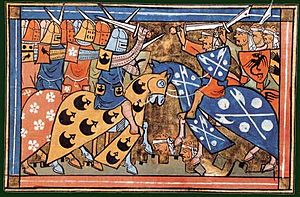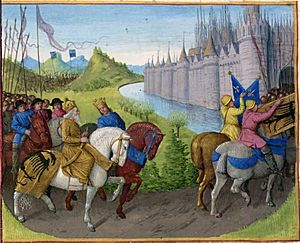Battle of Dorylaeum (1147) facts for kids
Quick facts for kids Battle of Dorylaeum (1147) |
|||||||
|---|---|---|---|---|---|---|---|
| Part of the Second Crusade | |||||||
 Combat in the 2nd Crusade, French manuscript, 14th century |
|||||||
|
|||||||
| Belligerents | |||||||
| Holy Roman Empire | Sultanate of Rum | ||||||
| Commanders and leaders | |||||||
| Conrad III (WIA) | Mesud I | ||||||
| Strength | |||||||
| unknown | unknown | ||||||
| Casualties and losses | |||||||
| from 63% to 90% of army is killed, missing or captured (90% is an unreliable figure - see text) | unknown | ||||||
The second Battle of Dorylaeum happened near Dorylaeum in October 1147. It was part of the Second Crusade. This wasn't just one fight. It was a series of battles over several days. The German crusader army, led by Conrad III, was defeated. They lost to the Seljuk Turks, whose leader was Sultan Mesud I.

Why the Battle Happened
The German crusader army and the Byzantine Empire had some disagreements. There were even small fights between them. Because of this, the Germans were moved by boat from near Constantinople to the Asian side of the Bosphorus strait.
The crusaders didn't have enough supplies. They decided to march through Anatolia (modern-day Turkey). Their goal was to reach the Holy Land by land.
The Fight Begins
As the crusaders marched into Anatolia, they entered an area. This area was a borderland between the Byzantines and the Seljuk Turks. Once they left Byzantine control, the German army faced constant attacks. The Turks were very good at quick, surprise attacks.
- The crusader foot soldiers were poorer and had fewer supplies.
- They were easy targets for the Turkish horse archers.
- Many crusaders were killed or captured.
The land they marched through was dry and empty. The army couldn't find more supplies. They also suffered from thirst.
When the Germans were about three days' march past Dorylaeum, their leaders decided to turn back. They wanted to regroup. As the crusaders started to retreat on October 25, the Turkish attacks got worse. The German army lost its order. The retreat quickly turned into a panicked escape. Many crusaders were killed. Even Conrad, their leader, was hit by arrows.
The crusaders lost almost all their baggage. An old record says the Turks became rich. They took gold and silver like they were just pebbles.
What Happened Next
When the crusaders reached areas controlled by the Byzantines, the Turkish attacks stopped. Some people at the time blamed the Byzantines for the loss. They said the Greek guides and local people helped the Seljuks. However, there is no strong proof for this idea. The Byzantine emperor, Manuel I, had quickly made a peace deal with the Seljuk sultan.
It's hard to know exactly how many German crusaders died. One writer said only a small part of the army was left. Out of 113 named knights and nobles, 22 died. 42 survived, and 49 are not accounted for. Knights and nobles had better armor and supplies. So, they were more likely to survive than the foot soldiers. This shows that the army was not completely wiped out. The main fighting force of Conrad's army, like the knights, stayed mostly together. But their spirits were low.
Later, the Germans joined the French crusaders at Nicaea. The French were led by Louis VII of France. Together, they marched along the coast of western Anatolia. They faced more Seljuk attacks. Conrad and his best soldiers then took ships from Ephesus. Conrad sailed back to Constantinople. There, he made peace with the Byzantine emperor.
The rest of the German crusaders, with the French, went to Attalia. Some were then shipped to Antioch. We don't know how many survived the overland journey to Antioch. Emperor Manuel I later provided ships to take Conrad and his group to Palestine.
The Second Crusade eventually failed. They could not capture the city of Damascus.
A German writer from Würzburg wrote about meeting many soldiers who returned home. These were likely the wealthier soldiers. They had been captured by the Turks. But they were later freed by, or with help from, the Armenians of Cilicia.

